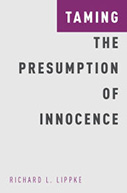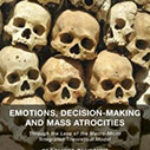Taming the Presumption of Innocence

Author: Richard Lippke
Publisher: New York; Oxford, UK: Oxford University Press, 2016. 286p.
Reviewer: Sandra G. Mayson | September 2016
Taming the Presumption of Innocence is a milestone. It appears, astonishingly, to be the only contemporary book-length treatment of the presumption of innocence by a U.S. author (although at least one academic journal, Criminal Law and Philosophy, has dedicated a recent volume to the subject). Its scope is vast: Richard Lippke aspires to cut through a wilderness of theoretical and legal confusion about the presumption of innocence, propose a focused vision of the presumption, and defend that vision against objections. He ties together a series of topical debates that have largely run on separate tracks, including debates over the legal and moral limits of pretrial detention and collateral consequences of conviction.
The central target of the book is the work of scholars who have “cast the presumption of innocence as a panacea, of sorts, for many of the perceived ills of our contemporary approach to crime and punishment” (p. 1). These scholars propose that the presumption imposes moral limits—and so should impose legal ones—on police conduct, the treatment of pretrial defendants, the treatment of people with past arrests and convictions, and the scope of the criminal law, among other things. Lippke rejects this expansive view. He defends a narrow understanding of the presumption of innocence as an evidentiary mechanism designed to ensure that trials function as “moral assurance” procedures to establish the guilt of the accused. Outside trial, Lippke contends, the presumption of innocence is incoherent. Invoking it as a constraint on state or private power is amorphous rhetoric that cannot provide effective moral or legal guidance.
Lippke’s approach is conceptual. He notes that, in any context, one might ask a range questions about the presumption: Who must presume the innocence of whom? For what purpose? What rebuts the presumption? And what happens when it is rebutted? At trial, Lippke points out, the answers are relatively clear. The jury (or judge in a bench trial) must presume the innocence of the defendant in order to put the state’s case to an exacting test. If proof beyond a reasonable doubt rebuts the presumption, the jury should convict; if the State fails to rebut the presumption, the jury should acquit. In other contexts, however, the answers are not clear at all. Consider the pretrial phase. Must the police simultaneously strive to identify the perpetrator of a crime and presume that person’s innocence? What does that entail? It is equally hard to say what should be understood to rebut a presumption of innocence in the pretrial phase or what should happen if it is rebutted.
Lippke’s deeper point is that invoking the presumption of innocence as antidote to every pathology of contemporary criminal justice is actually counterproductive. In Lippke’s view, the problem with the perceived excesses of law enforcement in the pretrial and post-conviction contexts is not that the state fails to treat people as innocent. Rather, the problem is more basic: The state infringes people’s liberty and privacy without good cause. A generalized “presumption of innocence” provides no clarity on when infringements of individual liberty are justified—when, for instance, police are justified in stopping someone on the street or arresting her; when the state is justified in collecting DNA or detaining a person pretrial; or when state or private employers are justified in refusing to hire someone on the basis of past conviction. On the contrary, Lippke suggests, invoking the presumption of innocence obscures the fact that these kinds of infringements require particular kinds of justification, and hampers debate about what kind of justification should suffice. We would be better off identifying the specific right infringed, and clarifying the limits relevant to that kind of infringement.
In developing his point, Lippke makes a positive case for a robust understanding of the presumption of innocence at trial. He argues that it requires the jury to begin the trial by presuming the material innocence of the accused—to deliberately adopt the confidence in his innocence that one would feel for a good friend. This framing device encourages the jury to view the state’s evidence, as it comes in, with skepticism. Only when the jury can no longer reconcile the evidence with material innocence may it forsake this perspective. The presumption thus operates in concert with a demanding standard of proof to ensure that trial provides “moral assurance” against punishment of the innocent.
Lippke also strives to identify the more specific principles that he thinks do constrain the treatment of people entangled with the criminal justice system, and their consequences for law and policy. In the pretrial context, for instance, he argues that the prohibition on pretrial punishment requires strict criteria for pretrial detention. In the post-punishment context, he argues that a person who has fully served her sentence ought to have full legal status, equal to people with no prior conviction—and that this requires a ban on collateral consequences. As for people subject to “incomplete prosecutions,” we should simply remember that their guilt has not been established, and make “sensible distinctions” between mistaken prosecutions of the innocent and prosecutions abandoned for other reasons (p. 211). His specific conclusions in these arenas are debatable, but his point is that these are precisely the debates we should be having.
Lippke’s overarching argument—that we should not seek to extend the presumption of innocence outside of trial—is compelling. The pretrial phase offers a good illustration. Scholars and laypersons alike tend to assume that the presumption applies in this sphere. Yet they generally do not argue that police, prosecutors and courts must adopt a stance of trust in the material innocence of every suspect and defendant. Scholars tend to define the presumption, rather, as prohibiting the state from judging defendants’ guilt or inflicting punishment prior to conviction on proof beyond a reasonable doubt. But invoking the “presumption of innocence” here adds nothing. The relevant principle is, instead, the prohibition on pretrial punishment, which (unlike the presumption of innocence) constitutesa direct limit on state action, and one with constitutional force in the pretrial arena.
For a reader sympathetic to Lippke’s argument, the book’s greatest flaw may be that it offers too much of a good thing. Lippke continually circles back to his core points, and at times it feels like he is battling a straw man. Contrary to what his title might imply, the presumption of innocence has not run wild. The U.S. Supreme Court has emphatically limited it to trial, as Lippke notes. Given that his dispute is mainly with other scholars, and that the clash is over analytical approaches rather than fundamental values, he might have handled it in fewer words.
The cost of so extensively demonstrating why the presumption of innocence is best understood as a procedural right at trial is that Lippke does not reach the difficult questions about the relationship of that trial right to the reality of our plea-bargaining system. Understood on Lippke’s terms, to what extent does the presumption of innocence shape plea-bargaining? Many scholars, including Lippke himself, have recently proposed that we shift from bargained negotiation toward a more administrative, quasi-inquisitorial or mediated system of adjudication; what role should the presumption of innocence play if we reform criminal justice along those lines? Lippke has grappled with this question in prior work, but without the benefit of the deep analysis of the presumption that he has now developed. Taming the Presumption could have done more to integrate its analysis with the rest of his oeuvre.
Relatedly, the most interesting question about the presumption of innocence might not be whether it should have legal force outside the trial context, but rather why it is so often invoked. One possibility is that the rhetorical power of “innocence” is invoked to counter the assumption that people with past or ongoing criminal justice contacts occupy a lesser moral and legal status, such that their liberty deserves less protection. The refrain that such people are “presumed innocent” might simply be intended to assert that there is no basis for the state to treat their liberty with any less concern than a wholly innocent person’s. Lippke acknowledges something like this in the Epilogue, where he writes that perhaps “part of the point of urging a pretrial [presumption of innocence] is to ensure that suspects and formally charged persons are treated with dignity,” and without “contempt or abuse” (235). But this discussion is late and brief.
Finally, Lippke makes an effective case for identifying the more specific principles that should constrain the treatment of people entangled with the criminal justice system, but his sketch of those principles is incomplete. He does not really explore, for instance, the relationship between the principle against punishment of the innocent, the “non-presumption of guilt,” and the prohibition on state punishment without conviction.
Ultimately, though, these demands for extensions of Lippke’s argument just demonstrate how successfully he has made his point. Invoked outside the trial context, the “presumption of innocence” stands in for an array of more specific rights and limits on state action that we would do better to articulate, and enforce, directly. This book sets us on the path.
Sandra G. Mayson, Research Fellow, Quattrone Center for the Fair Administration of Justice
University of Pennsylvania Law School


